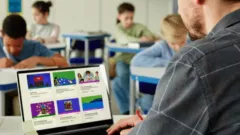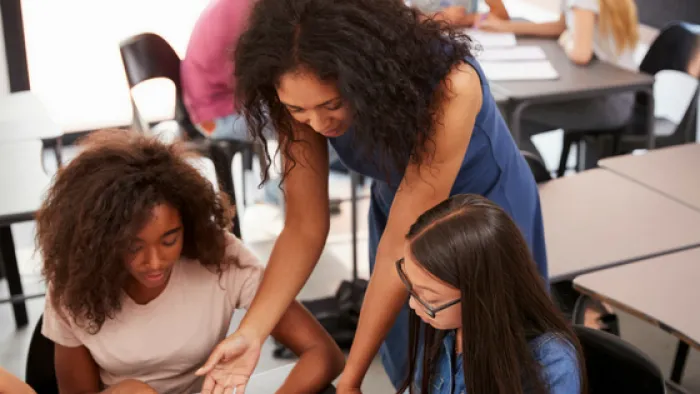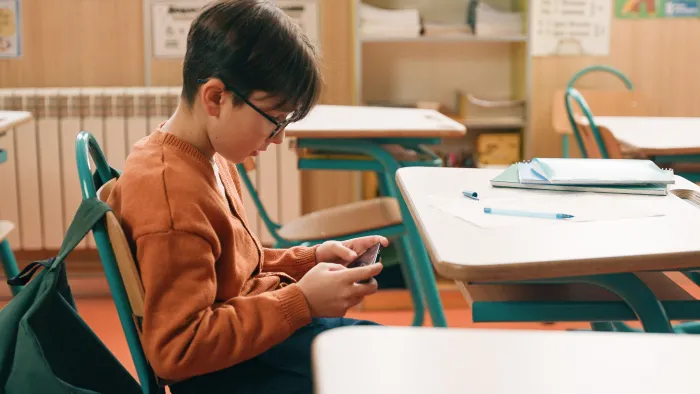Beyond cellphone bans, use these tips to increase students' ability to pay attention in class.

There's no doubt: Distraction caused by devices is a real issue, especially in schools. As many schools move toward cellphone bans (or some type of restricted access to phones), a focus on developing the right policies and support can definitely help decrease these distractions. But even total cellphone bans won't address the underlying issues of attention spans and impulse control that affect learning and classroom management. In other words, we can't just take things away—we also have to give kids the life skills they need.
To do that, we can offer levels of awareness, essential skills, and methods of reflection to "right-size" digital life and put devices in their proper place as tools. Below are some tips, strategies, and lessons for all grade levels to help students gain perspective and learn to self-regulate for a more media-balanced life.
Raise Awareness
First, it's important for kids to understand how our willpower is often undermined by design. Then they need to cultivate awareness of their own impulses, choices, and habits. This awareness gives us back some agency and a clearer picture of how—and why—we use tech as we do.
Design tricks
Help kids understand the bigger picture by revealing the tide they're actually resisting.
- Design tricks: Features like endless scrolling and autoplay are just a couple of methods that encourage us to stay online. Even little kids can examine why it can be hard to transition away from technology.
- Our brains and well-being: Once kids recognize the "by design" reasons why media and tech can feel addictive, they can learn about how these elements impact them.
Tech habits and self-regulation
Have kids assess their own impulses around media and tech. What do they actually do, and why?
- Tech habits: Sometimes there are patterns we follow and we're not even sure how or when they started. So it's good to build awareness of exactly what those habits are.
- Media choices: It's also helpful to be curious about why we make the media choices we do.
Adjust Settings
We know that kids are inundated daily with notifications of all kinds: messages, reminders, new YouTube videos, and more. One helpful step is to use the device, app, and game features that are already built in to assist with focus.
- Notifications: Once kids have a handle on what's most distracting, they can go into their settings and make adjustments at a general and more granular (app or game) level.
- Using Screen Time: For iOS devices, kids (and their caregivers) can use Screen Time, which tracks overall use time, individual app use, and more.
- Using Digital Wellbeing: For Android devices, kids can use Digital Wellbeing to track overall and individual app use, set Bedtime Mode, and more.
Build Skills
After building awareness of our media and tech use and adjusting settings, we can also practice skills to help foster personal balance.
- The ability to tolerate quiet, stillness, and boredom: Whether you call it mindfulness or something else, resisting the urge for constant stimulation is a skill worth building, even if you can only plant the seed. For kids who ask, "Why?" there are all sorts of studies to help you answer. Note: Instead of cracking down on kids who try to subvert quiet time, just build it into the practice of "noticing" what's going on around them—including disruption from peers!
- Extended attention span: Building a tolerance for boredom can increase attention span, but applying flow theory can help, too. This TED-Ed lesson is a good starting place. But having kids examine what triggers this state for them—and how they might apply it to "must-do" activities—might give them an attention-enhancing tool.
- In-person communication: Reminding students of when online communication falls short is a good place to start. Talk about nonverbal communication and the cues we get. Discuss the power of hearing someone's voice (like with podcasters and singers). And let students know that, even if it feels hard sometimes, science shows that face-to-face interactions can benefit our mental health more than online ones. Also, hugs!
- Other coping strategies: Though media and tech can actually play a positive role in soothing us during tough times, they can't be our only method of coping. Also, doing things like scrolling social media can increase mental health challenges. Deep breathing techniques, calm-down kits, creative projects, being in nature, and doing physical activities are just some of the ways we can encourage kids to deal with stress.

Offline and Off-Screen Activities for Minds-On Learning
Try these activities to take a break from screens!
Establish Personal Balance and New Habits
Once we have some preliminaries in place, we can determine what tech and media habits work with our personal sense of balance and enhance our well-being.
- Our values: Thinking about what's truly important to us allows an opportunity to see if our tech and media habits align with those values. For instance, if our family and friends are super important to us, but we're interrupting time with one group to answer notifications from another, we might want to make adjustments.
- Practical changes: In addition to adjusting settings, things like charging our phones outside of our bedrooms can allow for more quiet, screen-free rest. And if listening to music or podcasts helps with sleep, shutting down other apps and notifications during that time can stop the scrolling.
- Tech planners: Whether in class or at home, having a written agreement provides clear expectations and reminders for when we slip back into old habits that might not be serving us.
Practice Reflection
Our relationship to media and tech is always in process: As kids develop, their use of media and tech will change. Not only that, but tech itself will definitely advance (like artificial intelligence!). So it's important for us to periodically assess how tech use is impacting us and our relationships, aligning with our values, and fitting into overall balance.
- The big picture: Take a look at screen use regularly to see how it's balanced with other activities. Maybe we're going through a tough time, have a super-fun new game, or are in a new relationship that's prompting tons of texting. Changes in circumstances or new tech might mean we have to recalibrate.
- Self-awareness while using screens: We also need to reflect in the moment: Is this video game level too frustrating? Is scrolling Instagram making me feel anxious? Learning to be aware of how our bodies and minds are reacting to media and tech helps us know when it's time to stop and move on to something else.
Support Each Other
Kids and adults alike are facing similar challenges. Ultimately, we're all in this together, so leading with empathy and starting with "we" instead of "you" includes everyone in the conversation, without condemnation.
- Classroom camaraderie and discussions: Your students' cellphones may not be allowed in class, but that doesn't mean they're not fighting distraction the minute devices are back in their hands—and while they're doing homework. Help support them by giving them these strategies and modeling your own healthy habits.
- Family engagement: Help families get on the same page so all layers of kids' lives can form the fabric of their future healthy relationship to media and tech.










